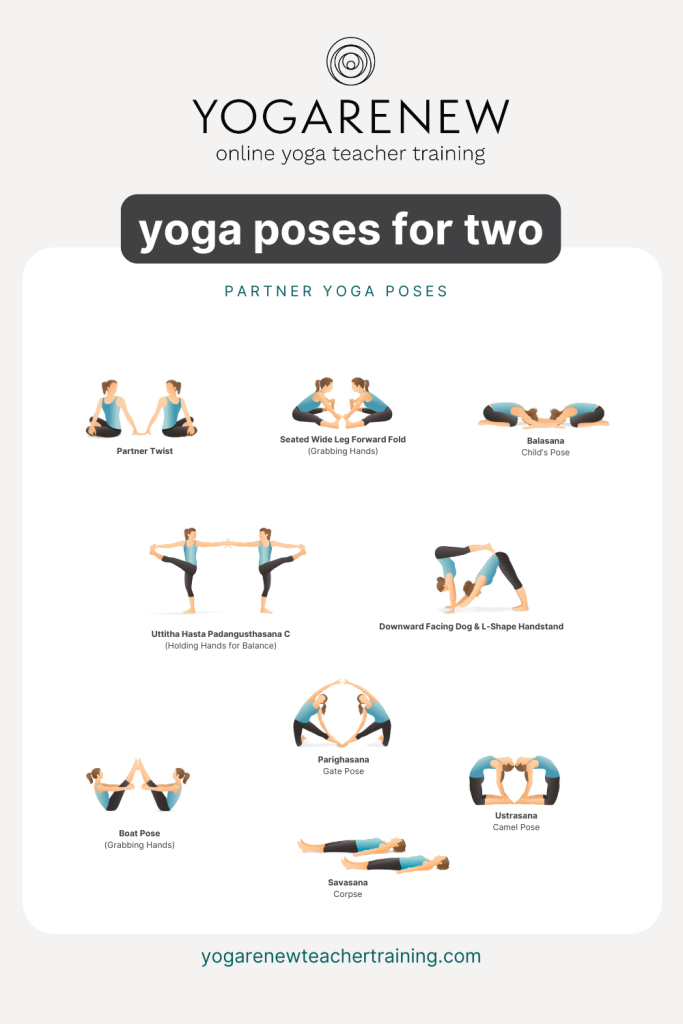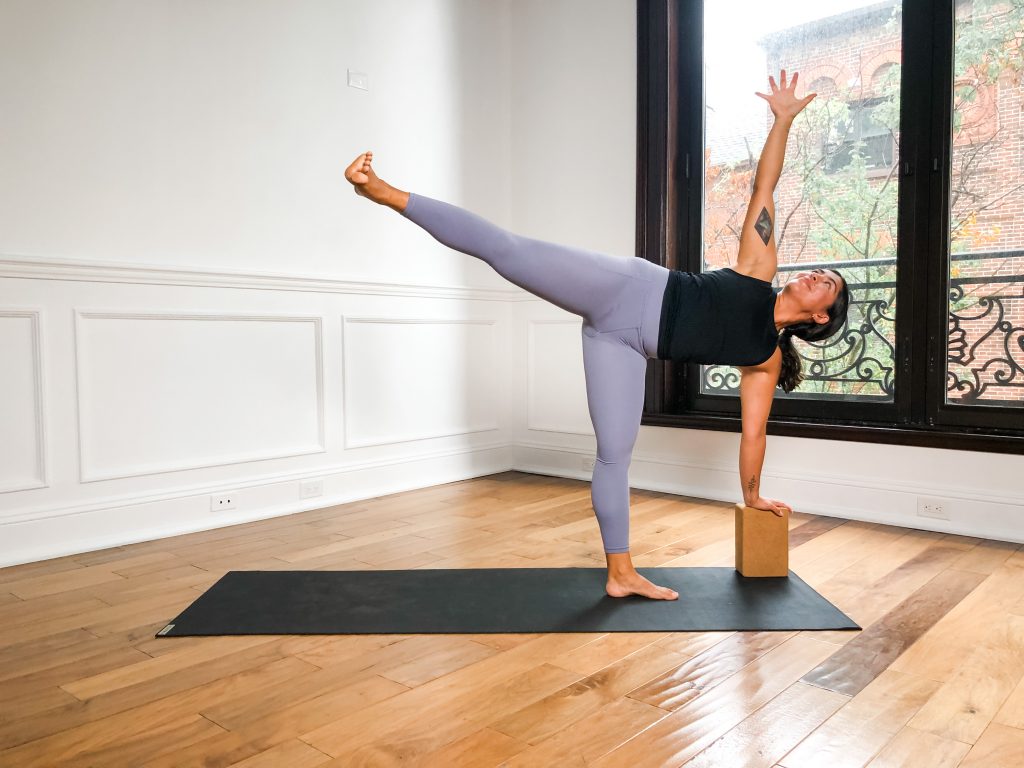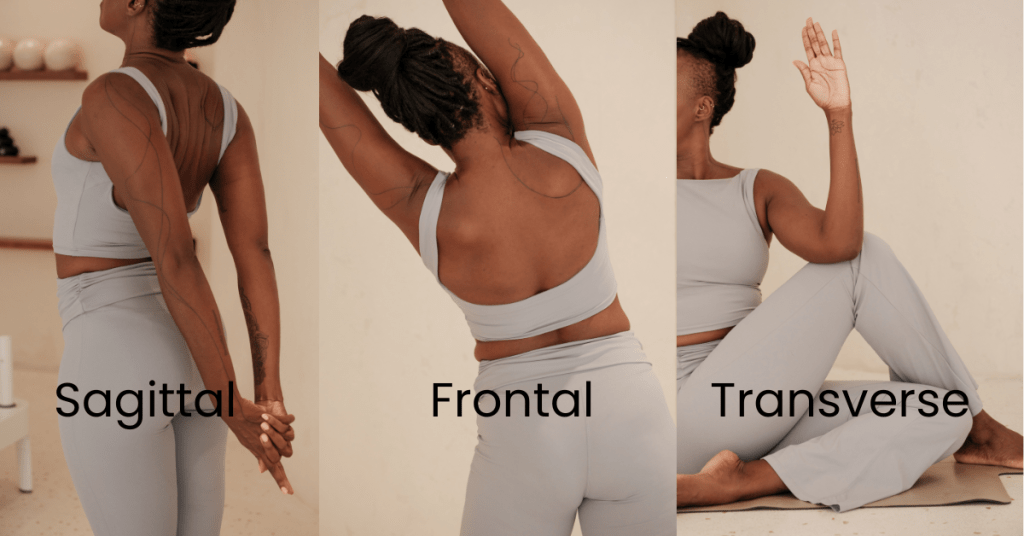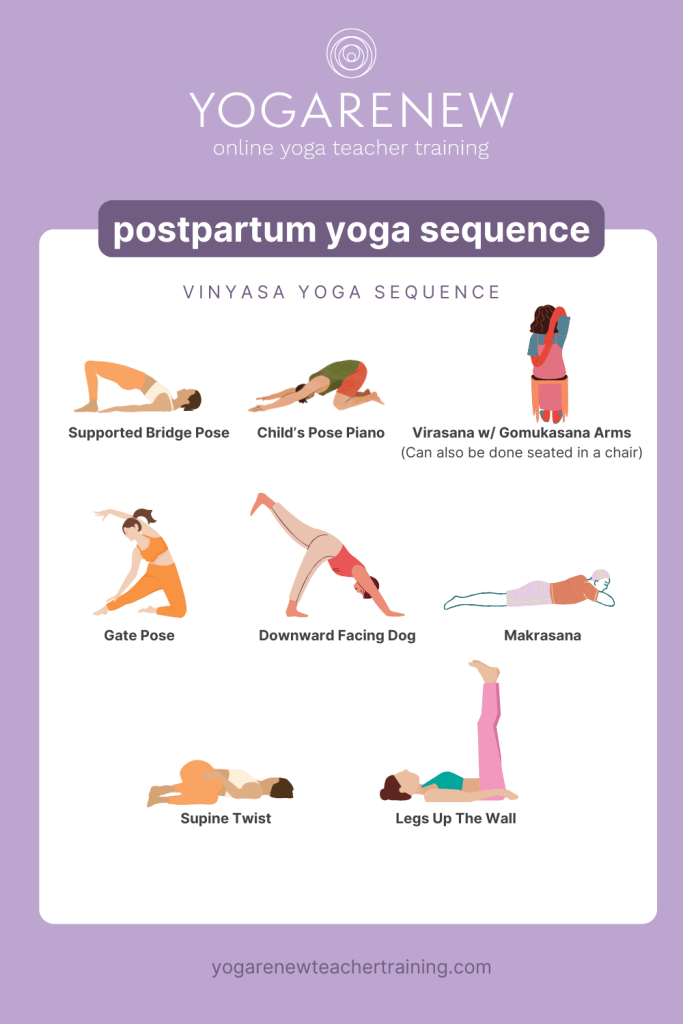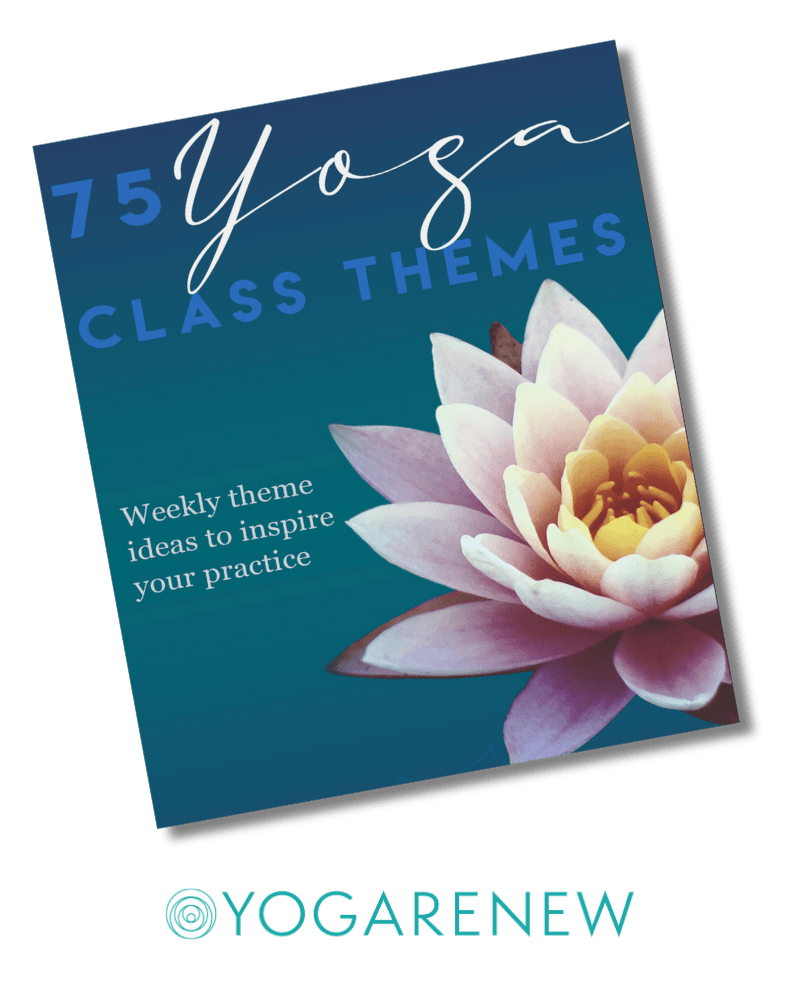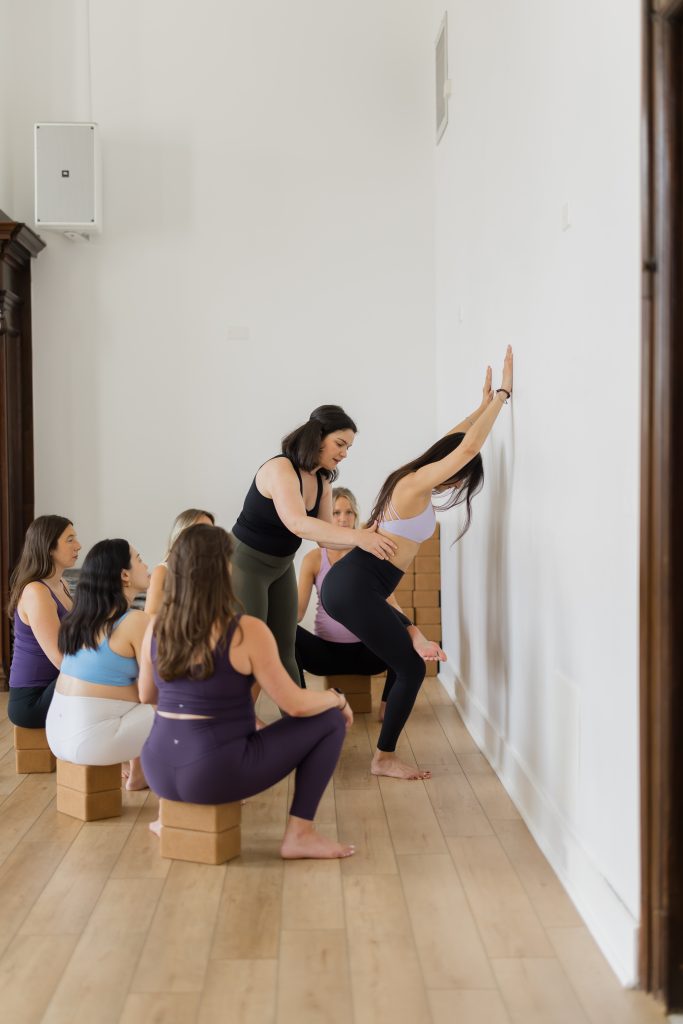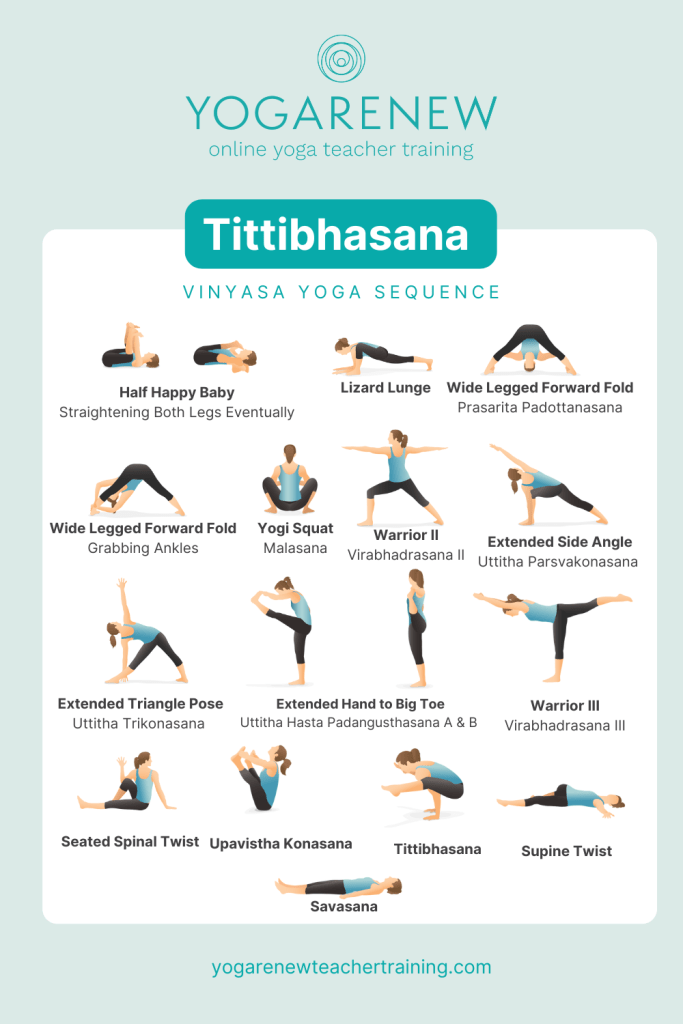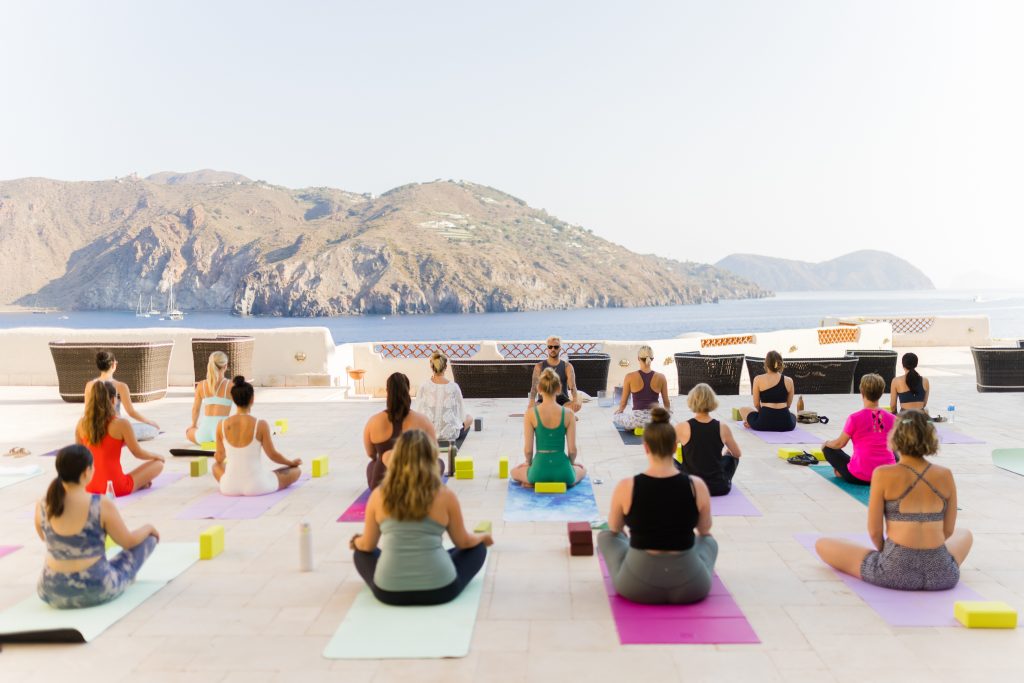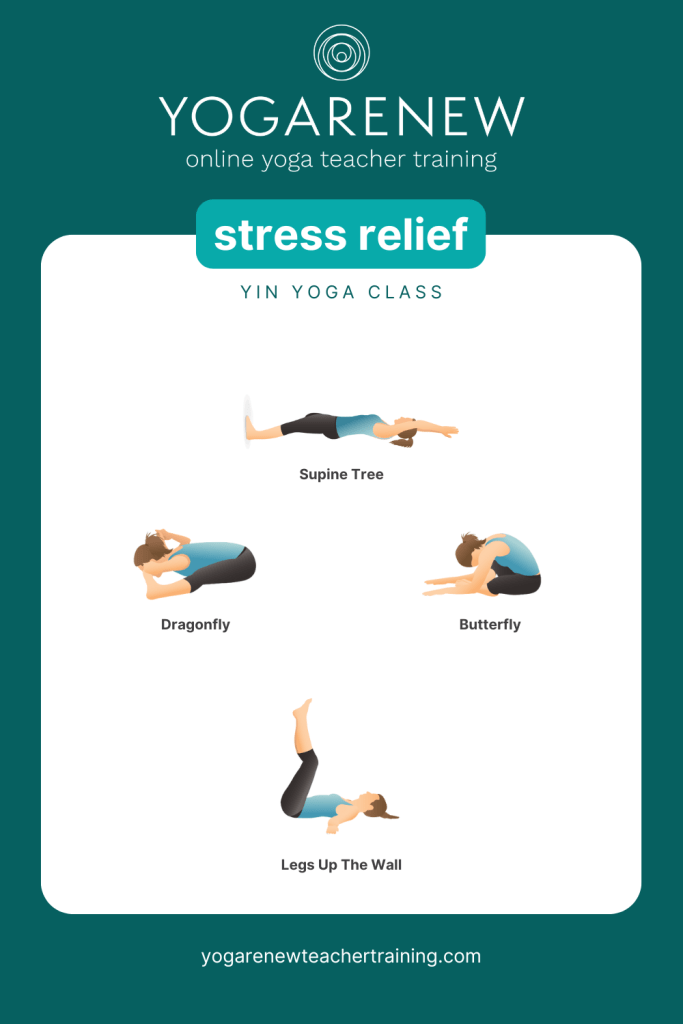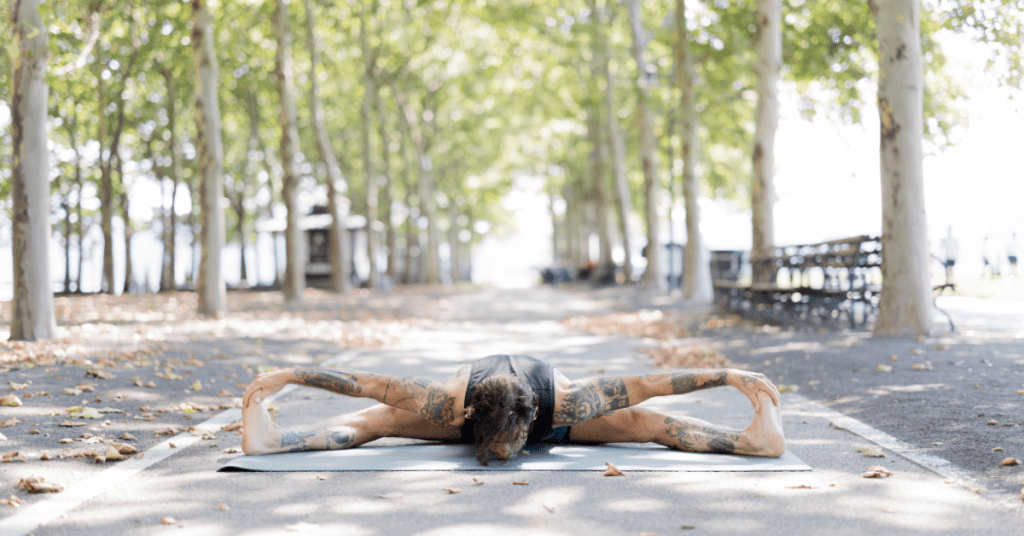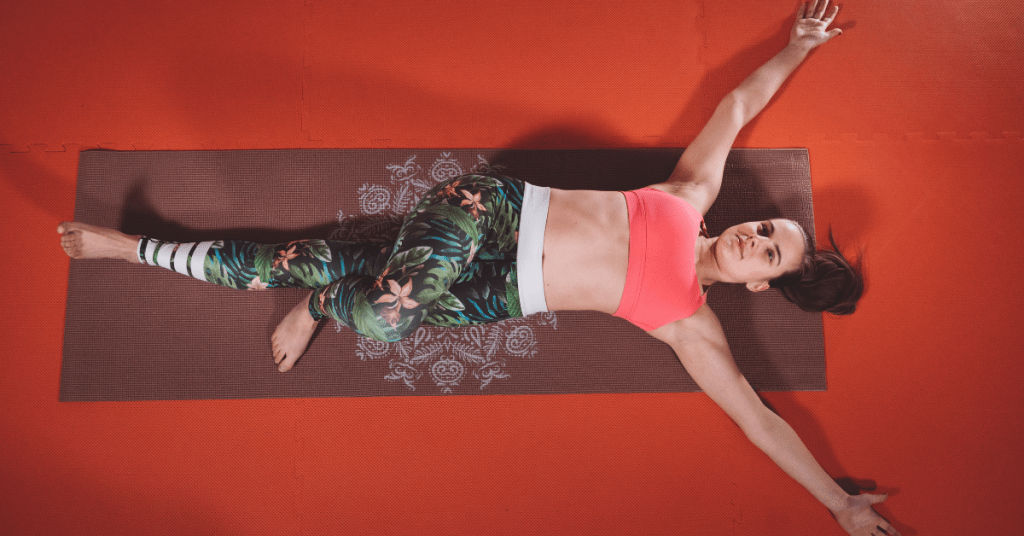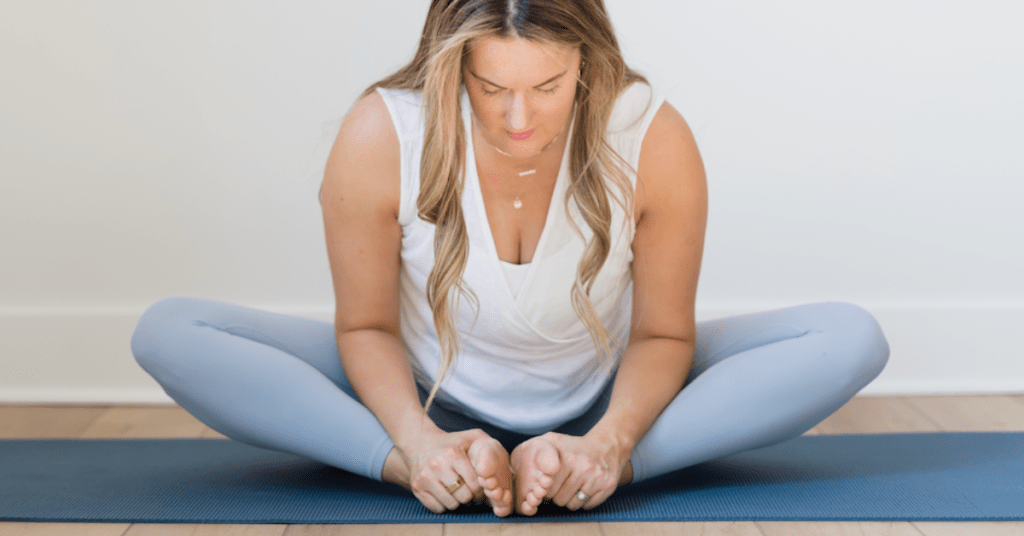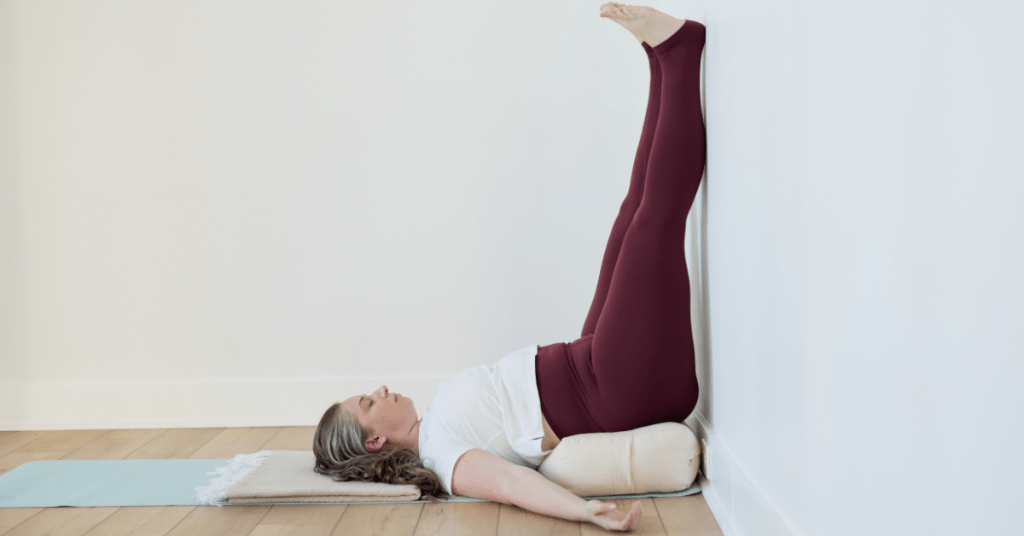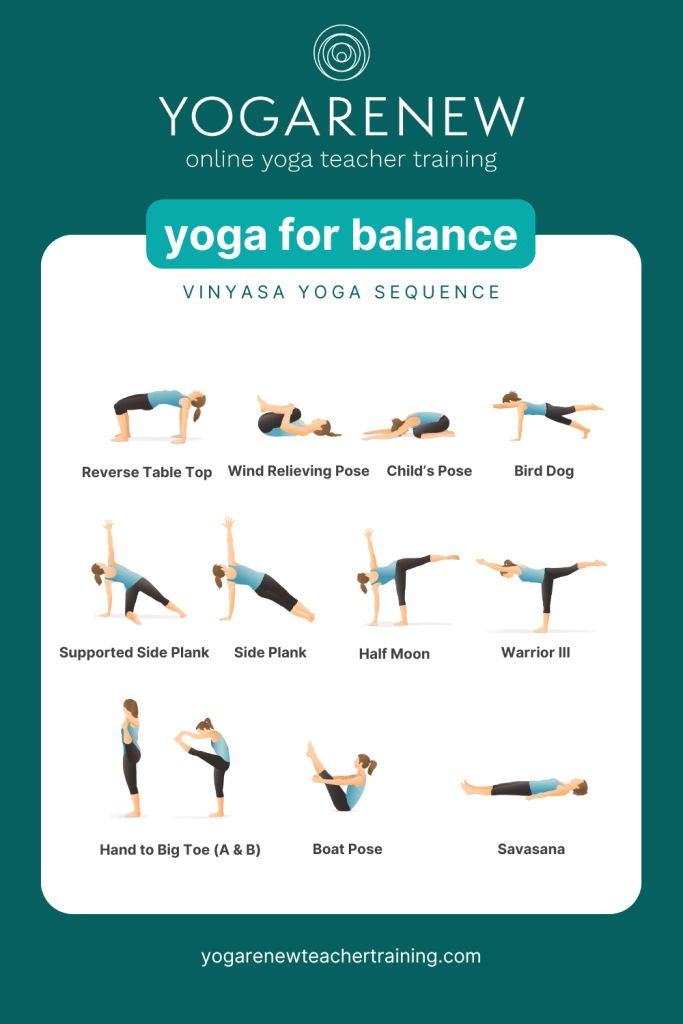
Maintaining balance isn’t just about staying upright—it’s about cultivating a deep sense of inner stillness, physical strength, and mental focus. Whether you’re navigating a hectic day or challenging transitions on the mat, yoga for balance can help you feel more stable, centered, and in control. In this post, we’ll explore 12 powerful yoga poses that promote balance in the body and mind, with tips for integrating them into your practice.
Why Practice Yoga for Balance?
Balance in yoga isn’t only about standing on one leg. It also involves core engagement, joint stability, and mental clarity. Regular practice of yoga for balance improves posture, builds strength in often-overlooked muscles, and enhances proprioception (your body’s sense of its position in space). The following poses are excellent for anyone looking to enhance stability—whether you’re new to yoga or deepening your practice.
1. Reverse Table Top (Ardha Purvottanasana)
A great way to activate your glutes, core, and shoulders, Reverse Table Top helps build foundational strength. Start seated with your hands behind you and feet hip-width apart. Press into your palms and feet to lift your hips, creating a straight line from shoulders to knees. Hold for 5 breaths to engage stabilizing muscles.
Balance benefit: Strengthens the posterior chain and opens the front body, countering common postural imbalances.
2. Wind-Relieving Pose (Pawanmuktasana)
While often seen as a gentle stretch, Wind-Relieving Pose also teaches core control and breath-body coordination. Lying on your back, hug one knee—or both—into your chest, gently pressing the thigh toward your belly.
Balance benefit: Encourages awareness of core engagement and alignment in the lower spine.
3. Child’s Pose (Balasana)
This grounding posture is a reset for the nervous system. Kneel and fold your torso over your thighs, resting your forehead on the mat. Focus on deep, steady breathing.
Balance benefit: Promotes mindfulness and body awareness, foundational elements for physical balance.
4. Bird Dog (Dandayamana Bharmanasana)
From tabletop position, extend your right arm forward and left leg back. Engage your core to prevent wobbling. Hold for 3–5 breaths and switch sides.
Balance benefit: Strengthens cross-body coordination and improves spinal stability.
5. Supported Side Plank (Vasisthasana with Knee Down)
This beginner-friendly variation of Side Plank uses the bottom knee for support. Stack the shoulder over the wrist and lift your top arm. Keep the hips lifted and engage your core.
Balance benefit: Builds lateral stability and confidence before advancing to full Side Plank.
6. Side Plank (Vasisthasana)
A classic pose for core and balance training. Stack your feet and hips as you lift into a strong line. Reach the top arm toward the ceiling and gaze upward or forward for stability.
Balance benefit: Challenges core engagement and strengthens the wrists, shoulders, and obliques.
7. Half Moon (Ardha Chandrasana)
This standing balance pose combines leg strength with full-body awareness. From Warrior 2, shift your weight onto the front leg, lift the back leg, and reach the top arm up while gazing forward or up.
Balance benefit: Improves coordination and builds ankle, leg, and core strength.
8. Warrior III (Virabhadrasana III)
From a standing position or a high lunge, shift forward and lift the back leg while keeping your torso parallel to the ground. Stretch your arms forward or alongside your body.
Balance benefit: Strengthens the hamstrings, glutes, and back muscles while demanding laser focus.
9. Hand to Big Toe Pose A & B (Utthita Hasta Padangusthasana)
In A, extend one leg straight forward while standing on the other, holding the big toe. In B, open the lifted leg to the side.
Balance benefit: Enhances flexibility and strengthens stabilizing muscles of the legs and hips.
10. Boat Pose (Navasana)
Sit with knees bent and feet on the floor. Lean back slightly and lift your legs, balancing on your sit bones. Extend your arms forward or up.
Balance benefit: Activates the deep core muscles essential for posture and control in other balancing poses.
11. Savasana (Corpse Pose)
While not a physical balancing pose, Savasana is key to integrating your practice. Lie flat on your back, arms relaxed by your sides, and allow your body to fully rest.
Balance benefit: Encourages mental stillness and nervous system regulation—crucial for balanced living.
Tips for Improving Your Balance in Yoga
- Engage your core: Most balance challenges come down to weak or inactive core muscles.
- Focus your gaze (drishti): A steady visual point helps ground the mind and body.
- Practice barefoot: Feeling the floor under your feet improves proprioception.
- Slow down: Mindful movement builds deeper awareness and control.
- Breathe deeply: Holding your breath creates tension. Full, steady breaths stabilize the nervous system.


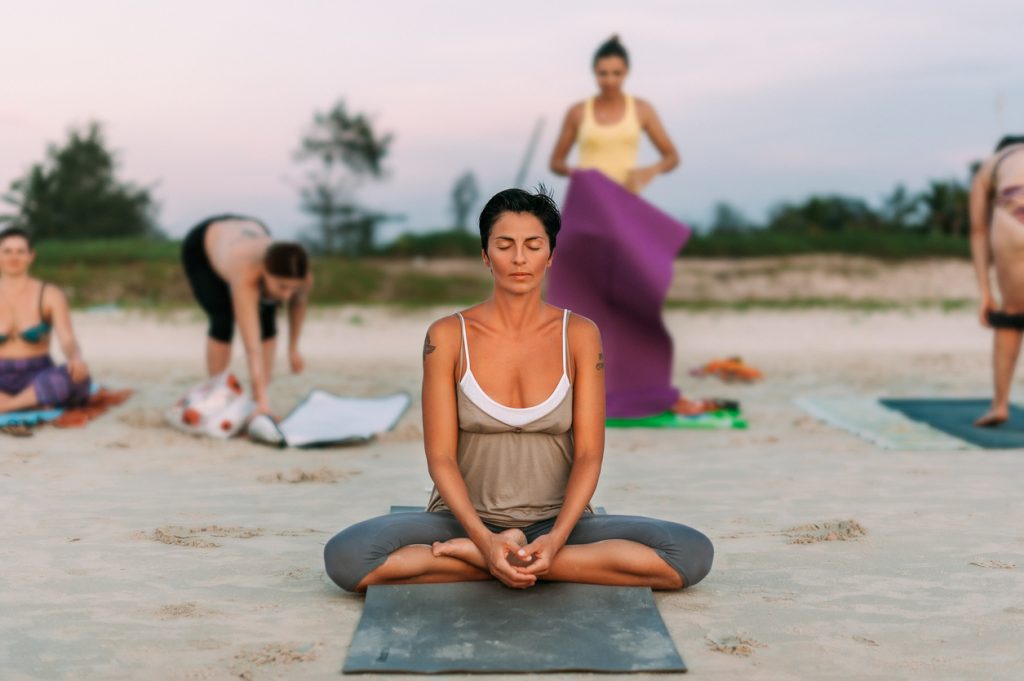
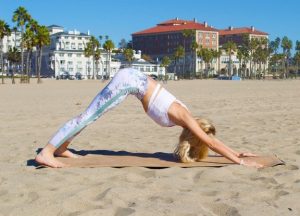 This pose is very popular in yoga sequences, especially in vinyasa yoga. The benefits of Downward Facing Dog include stretching the hamstrings, calves, shoulders and hands while strengthening the legs and arms. It also makes your feel energized and helps calm the brain which makes it an ideal pose to relieve stress. This classic yoga pose can be practiced pretty much anywhere however, practicing it on the sand can allow your body to sink even deeper into it. Begin in tabletop position with your knees stacked directly under your hips and your wrists stacked under your shoulders. Exhale while tucking your toes and lifting your knees off the sand. Spread your fingers and press your hands down in front of you while straightening your back as much as possible. Gently bend your knees, one at a time, working your way into your own version of Downward Facing Dog. Bring your gaze towards your feet while aligning your hand with your spine creating a straight line. Take a few deep breaths and when you’re ready to exit the pose, gently lower your knees back onto the sand into tabletop position and release into Child’s Pose.
This pose is very popular in yoga sequences, especially in vinyasa yoga. The benefits of Downward Facing Dog include stretching the hamstrings, calves, shoulders and hands while strengthening the legs and arms. It also makes your feel energized and helps calm the brain which makes it an ideal pose to relieve stress. This classic yoga pose can be practiced pretty much anywhere however, practicing it on the sand can allow your body to sink even deeper into it. Begin in tabletop position with your knees stacked directly under your hips and your wrists stacked under your shoulders. Exhale while tucking your toes and lifting your knees off the sand. Spread your fingers and press your hands down in front of you while straightening your back as much as possible. Gently bend your knees, one at a time, working your way into your own version of Downward Facing Dog. Bring your gaze towards your feet while aligning your hand with your spine creating a straight line. Take a few deep breaths and when you’re ready to exit the pose, gently lower your knees back onto the sand into tabletop position and release into Child’s Pose.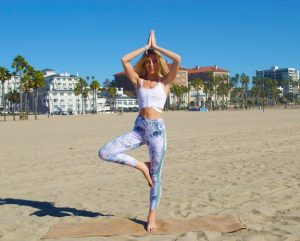 I don’t know about you but something about being by the ocean provides peacefulness and balance to my body and soul; why not practice a pose that embodies that? Benefits of this pose include stretching the thighs, core and shoulders while strengthening the spine, thighs and calves. Tree Pose is a great way to ground yourself and focus on your breathing while improving your balance. Begin in Mountain Pose (Tadasana); inhale while lifting your arms towards the sky and exhale, bringing your hands by your heart. Choose a focal point to provide balance and slowly lift your right foot off the sand and place it on your left ankle. Taking your time, lift your right foot further until it reaches the side of your left knee. Take a few deep breaths here and whenever you’re ready. return to Mountain Pose; repeat this pose on the opposite side.
I don’t know about you but something about being by the ocean provides peacefulness and balance to my body and soul; why not practice a pose that embodies that? Benefits of this pose include stretching the thighs, core and shoulders while strengthening the spine, thighs and calves. Tree Pose is a great way to ground yourself and focus on your breathing while improving your balance. Begin in Mountain Pose (Tadasana); inhale while lifting your arms towards the sky and exhale, bringing your hands by your heart. Choose a focal point to provide balance and slowly lift your right foot off the sand and place it on your left ankle. Taking your time, lift your right foot further until it reaches the side of your left knee. Take a few deep breaths here and whenever you’re ready. return to Mountain Pose; repeat this pose on the opposite side.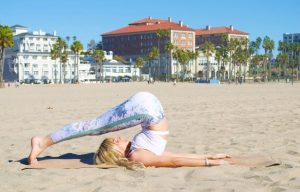 This pose is excellent at reducing back pain and stress, calming the mind and stretching the spine and shoulders. To get into this pose, simply begin in a shoulder stand and slowly bring your extended legs back towards your head until your toes touch the mat behind your head. Remember to bring your chin away from your sternum and keep your hands on your lower back for additional support or release them onto the mat and stretch them behind you. This pose can be held for a few minutes; when you feel ready to exit, bring your hands to your lower back again and exhale while slowly lowering your legs down towards. This a a great pose for the beach because it encourages deep relaxation and stress relief.
This pose is excellent at reducing back pain and stress, calming the mind and stretching the spine and shoulders. To get into this pose, simply begin in a shoulder stand and slowly bring your extended legs back towards your head until your toes touch the mat behind your head. Remember to bring your chin away from your sternum and keep your hands on your lower back for additional support or release them onto the mat and stretch them behind you. This pose can be held for a few minutes; when you feel ready to exit, bring your hands to your lower back again and exhale while slowly lowering your legs down towards. This a a great pose for the beach because it encourages deep relaxation and stress relief.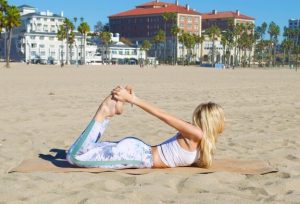 Take a deep breath and say goodbye to any tension. Being by laying on your stomach with your arms extend by your sides with your palms up. Take a deep exhale and reach for your heels with your hands while bending your knees. Hold onto your feet while trying to lift your thighs slightly off the mat and gaze forward. Keep i mind that it might be harder to breathe in this posture but make sure to keep breathing steadily. Stay in this pose for about 30 seconds and release your legs and arms towards the mat while taking a deep exhale. The benefits of this pose include improving your posture, strengthening the back muscles and stretching your thighs, core, chest, throat and hips.
Take a deep breath and say goodbye to any tension. Being by laying on your stomach with your arms extend by your sides with your palms up. Take a deep exhale and reach for your heels with your hands while bending your knees. Hold onto your feet while trying to lift your thighs slightly off the mat and gaze forward. Keep i mind that it might be harder to breathe in this posture but make sure to keep breathing steadily. Stay in this pose for about 30 seconds and release your legs and arms towards the mat while taking a deep exhale. The benefits of this pose include improving your posture, strengthening the back muscles and stretching your thighs, core, chest, throat and hips.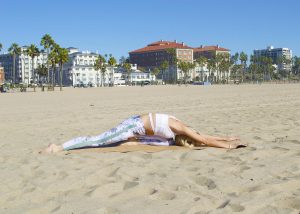 This pose is wonderful at lengthening the hip flexors, preparing the body for backbend poses as well as opening the hip joint and reducing stress and anxiety. Begin in seated position with your feet tucked under your glutes. Extend your right leg back on the mat while keeping your left leg bent in front of you. Take a deep inhale and as you exhale, release your body onto your front leg and extend your arms on the mat in front of you. Try to bring your forehand to touch the mat and close your eyes. Take a few deep breaths, allowing your body to sink even deeper into the pose with every exhale. To exit the asana, slowly walk your hands back up towards your torso and return to seated position.
This pose is wonderful at lengthening the hip flexors, preparing the body for backbend poses as well as opening the hip joint and reducing stress and anxiety. Begin in seated position with your feet tucked under your glutes. Extend your right leg back on the mat while keeping your left leg bent in front of you. Take a deep inhale and as you exhale, release your body onto your front leg and extend your arms on the mat in front of you. Try to bring your forehand to touch the mat and close your eyes. Take a few deep breaths, allowing your body to sink even deeper into the pose with every exhale. To exit the asana, slowly walk your hands back up towards your torso and return to seated position.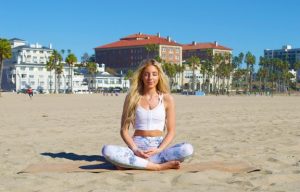 Now, let’s take a moment to sit still and breathe. Sit comfortably with your legs crossed, your spine straight and your hands in your lap. Close your eyes and take several deep breaths, trying to hold your inhale for a few seconds before exhaling. Try to eliminate any stressful or negative thoughts while bringing your entire focus o your breath. While continuing to breathe deeply, bring your attention to the sound of the ocean waves crashing endlessly against the shore, one by one. Inhale the fresh, salty breeze and feel your body sinking heavily into the sand.Let go of any fear or stress about what will happen tomorrow or the day after because all that is guaranteed is this moment, sitting cross legged on the sand in front of the vast ocean that covers our beautiful planet. In this moment, you are blessed and all you can do is immerse yourself in gratitude. You can attempt the Ujjayi breath which is often referred to as the “oceanic breath” and it is used to synchronize your breathing with the asana. This wonderful technique will enhance your yoga practice as well as increase the oxygen in your blood, relieve tension, detoxify your body and mind as well as help to increase your mind-body awareness. The Ujjayi breath consists of breathing through your nose, inhaling deeply and exhaling slowly through your nose. To practice, open your mouth and exhale making a “ha” sound. Noe, try this with your mouth closed but maintain the intensity of your exhalations. Every time your exhale, it should sound like ocean waves and this technique is ideal to practice while you’re in easy pose, during hatha yoga or simply when you’re stressed or frustrated.
Now, let’s take a moment to sit still and breathe. Sit comfortably with your legs crossed, your spine straight and your hands in your lap. Close your eyes and take several deep breaths, trying to hold your inhale for a few seconds before exhaling. Try to eliminate any stressful or negative thoughts while bringing your entire focus o your breath. While continuing to breathe deeply, bring your attention to the sound of the ocean waves crashing endlessly against the shore, one by one. Inhale the fresh, salty breeze and feel your body sinking heavily into the sand.Let go of any fear or stress about what will happen tomorrow or the day after because all that is guaranteed is this moment, sitting cross legged on the sand in front of the vast ocean that covers our beautiful planet. In this moment, you are blessed and all you can do is immerse yourself in gratitude. You can attempt the Ujjayi breath which is often referred to as the “oceanic breath” and it is used to synchronize your breathing with the asana. This wonderful technique will enhance your yoga practice as well as increase the oxygen in your blood, relieve tension, detoxify your body and mind as well as help to increase your mind-body awareness. The Ujjayi breath consists of breathing through your nose, inhaling deeply and exhaling slowly through your nose. To practice, open your mouth and exhale making a “ha” sound. Noe, try this with your mouth closed but maintain the intensity of your exhalations. Every time your exhale, it should sound like ocean waves and this technique is ideal to practice while you’re in easy pose, during hatha yoga or simply when you’re stressed or frustrated.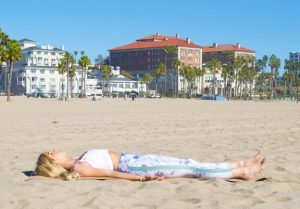 This posture will help you relax even more after getting out of Easy pose. Lay down on your mat or the sand with your legs extended in front of you and your arms by your sides with your palms facing up towards the sky. Close your eyes and bring your awareness to your breath once again but this time, don’t force deep inhalations or exhalations; instead, breathe naturally and simply bring your attention to your breathe. Allow the soothing sounds around you to increase your sense of mindfulness and purpose. The benefits of this asana are endless, a few of which are body awareness, stress reduction, better sleep quality and deep mind relaxation. This asana can be held for anywhere from 5 minutes to an hour and it might just end up in a wonderful nap in the sun.
This posture will help you relax even more after getting out of Easy pose. Lay down on your mat or the sand with your legs extended in front of you and your arms by your sides with your palms facing up towards the sky. Close your eyes and bring your awareness to your breath once again but this time, don’t force deep inhalations or exhalations; instead, breathe naturally and simply bring your attention to your breathe. Allow the soothing sounds around you to increase your sense of mindfulness and purpose. The benefits of this asana are endless, a few of which are body awareness, stress reduction, better sleep quality and deep mind relaxation. This asana can be held for anywhere from 5 minutes to an hour and it might just end up in a wonderful nap in the sun.